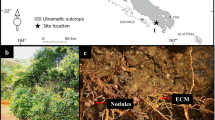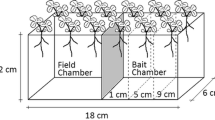Abstract
The influence of soilborne symbionts such as rhizobia or mycorrhizal fungi on plant response to ozone (O3) has not been well defined. Leguminous plants in the field are infected by both types of organisms, which influence plant nutrition and growth. We studied the effects of infection with Rhizobium leguminosarum biovar trifolii and/or Gigaspora margarita on response of subterranean clover (Trifolium subterraneum L. cv Mt. Barker) to O3. Exposures were conducted in greenhouse CSTR chambers using four O3 concentrations [charcoal-filtered (CF), 50, 100, or 150 ppb; 6 h day-1, 5 day wk-1 for 12 weeks] as main plots (replicated). Four inoculum types were subplot treatments, i.e., inoculated with one, both, or neither microorganisms. At 2-wk intervals, plants were exposed to 14CO2 and harvested 24 h later for determination of biomass and 14C content of shoots and roots. Ozone at 100 or 150 ppb suppressed clover growth during the experiment. Inoculation with G. margarita alone suppressed clover growth by the last two harvests, whereas R. leguminosarum alone enhanced growth during this time period. When both symbionts were present, the plants grew similarly to the noninoculated controls. Shoot/root ratios were increased by 100 or 150 ppb O3 compared to that for CF-treated plants. Shoot/root ratios were greater for all inoculated plants compared to noninoculated controls. Under low O3 stress (CF or 50 ppb), plants inoculated with both R. leguminosarum and G. margarita transported a greater proportion of recent photosynthate (14C) to roots than did noninoculated plants; we attribute this to metabolic requirements of the microorganisms. At the highest level of O3 stress (150 ppb), this did not occur, probably because little photosynthate was available and the shoots retained most of it for repair of injury. Statistically significant interactions occurred between O3 and inoculum types for shoot and total biomass. When averaged across harvests, 50 ppb O3 suppressed biomass in the plants inoculated with G. margarita alone. Apparently, the mycorrhizal fungus is such a significant C drain that even a small amount of O3 stress suppresses plant growth under these conditions.
Similar content being viewed by others
References
Alscher, R. G. and Wellburn, A. R. (eds.): 1994, Plant Responses to the Gaseous Environment, Chapman and Hall, London, U.K.
Bethlenfalvay, G. J., Brown, M. S. and Pakovsky, R. S.: 1982, Phytopathology 72, 889-893.
Box, G. E. P. and Cox, D. R.: 1964, J. R. Stat. Soc. Ser. B 26, 211-243.
Brewer, P. F. and Heagle, A. S.: 1983, Phytopathology 73, 1035-1040.
Cooley, D. R. and Manning, W. J.: 1987, Environ. Pollut. 47, 95-113.
Flagler, R. B., Patterson, R. P., Heagle, A. S. and Heck, W. W.: 1987, Crop Sci. 27, 1177-1184.
Heck, W. W., Philbeck, R. B. and Dunning, J. A.: 1978, Agricultural Research Service, Series No. ARS-S-181, pp. 32.
McCool, P. M. and Menge, J. A.: 1983, New Phytol. 94, 241-247.
McCool, P. M. and Menge, J. A.: 1984, Soil Biol. Biochem. 16, 425-427.
Miller, J. E.: 1988, in Heck, W. W., Taylor, O. C. and Tingey, D. T. (eds.), Assessment of Crop Loss From Air Pollutants, Elsevier Science Publishers, London, U.K., pp. 287-314.
Modjo, H. S. and Hendrix, J. W.: 1986, Phytopathology 76, 688-691.
Montes, R. A., Blum, U., Heagle, A. and Volk, R. J.: 1983, Can. J. Bot. 61, 2159-2168.
Rawlings, J. O.: 1988, Applied Regression Analysis: A Research Tool, Wadsworth and Brooks, Pacific Grove, CA.
Safir, G. R.: 1994, in Pfleger, F. L. and Linderman, R. G. (eds.), Mycorrhizae and Plant Health, APS Press, St. Paul, MN, pp. 239-259.
SAS Institute, Inc.: 1988, SAS/AF User's Guide: Version 6.03 Edition, SAS Institute, Inc., Cary, NC.
Shafer, S. R. and Schoeneberger, M. M.: 1991a, Environ. Pollut. 73, 163-177.
Shafer, S. R. and Schoeneberger, M. M.: 1991b, in Keister, D. L. and Creagan, P. B. (eds.), The Rhizosphere and Plant Growth, Kluwer Academic Publishers, Dordrecht, the Netherlands, pp. 377.
Tingey, D. T. and Blum, U.: 1973, J. Environ. Qual. 2: 341-342.
Vincent, J. M.: 1970, A Manual for the Practical Study of Root-Nodule Bacteria, International Biological Program Handbook 15. Blackwell Scientific Publication, Ltd., Oxford. p. 164.
Author information
Authors and Affiliations
Rights and permissions
About this article
Cite this article
MILLER, J.E., SHAFER, S.R., SCHOENEBERGER, M.M. et al. INFLUENCE OF A MYCORRHIZAL FUNGUS AND/OR RHIZOBIUM ON GROWTH AND BIOMASS PARTITIONING OF SUBTERRANEAN CLOVER EXPOSED TO OZONE. Water, Air, & Soil Pollution 96, 233–248 (1997). https://doi.org/10.1023/A:1026496420809
Issue Date:
DOI: https://doi.org/10.1023/A:1026496420809




